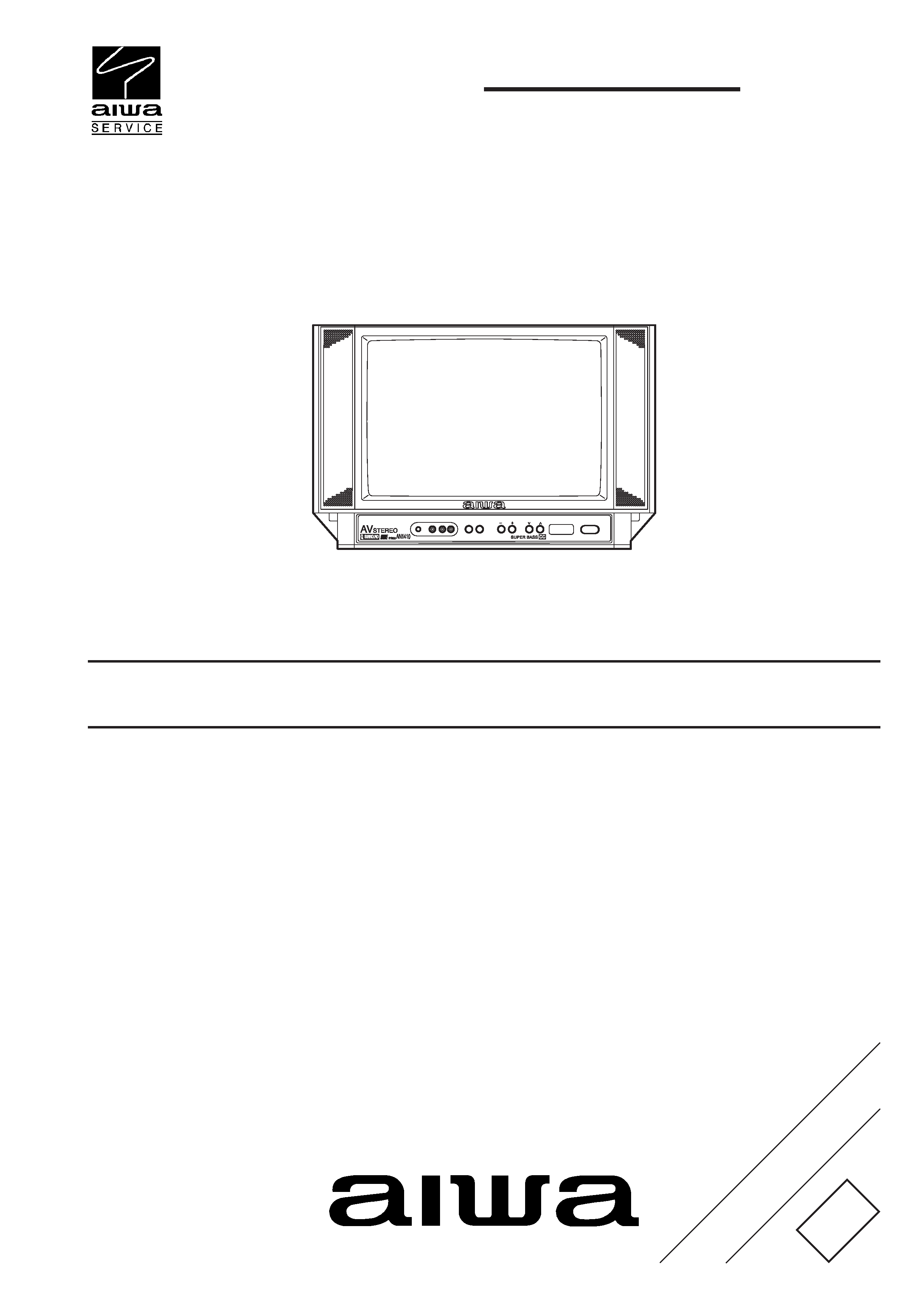
SERVICE MANUAL
DA
TA
COLOR TELEVISION
S/M Code No. 09-004-417-4S1
SUPPLEMENT
TV-AN1410 NH
· This Service Manual contains the additional information "NOTICES BEFORE REPAIRING",
"DISASSEMBLY INSTRUCTIONS" and "ADJUSTMENT" for the model TV-AN1410 (NH).
If requiring the other information, see Service Manual of TV-AN1410 (NH),
(S/M Code No. 09-99B-417-4R1).
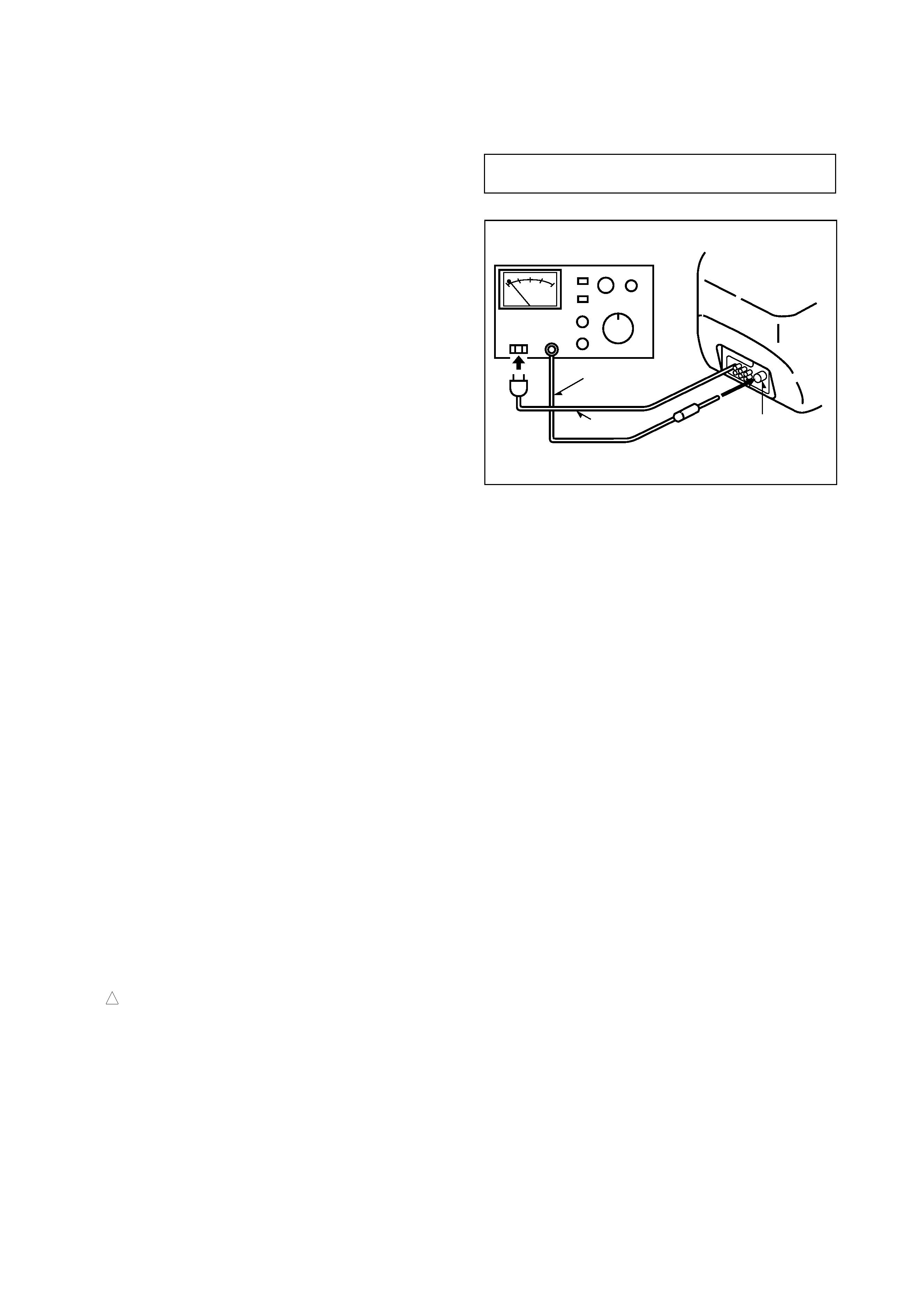
2
When servicing and checking on the TV, note the followings.
NOTICES BEFORE REPAIRING
To make the best use of this equipment, make sure to
obey the following items when repairing (or mending).
1. Do not damage or melt the tunicate of the leading wire on
the AC1 side, including the power supply cord.
2. Do not soil or stain the letters on the spec. inscription plates,
notice labels, fuse labels, etc.
3. When repairing the part extracted from the conducted side
of the board pattern, fix it firmly with applying bond to the
pattern and the part.
4. Restore the following items after repairing.
1) Conditions of soldering of the wires (especially, the
distance on the AC1 side).
2) Conditions of wiring, bundling of wires, etc.
3) Types of the wries.
4) Attachment conditions of all types of the insulation.
5. After repairing, always measure the insulation resistance
and perform the voltage-withstand test (See Fig-1).
1) The insulation resistance must be 1 M
when applying
500V per second.
2) In the voltage withstand test, apply 1 kV for 1 minute and
check that the GO lamp lights.
*
Breaking current set to 10 mA.
*
Connect the safety checker as shown in Fig-1, then
measure the resistance and perform the test.
*
Do not touch the equipment during testing.
*
For details of the safety checker, refer to the supplied
Operation manual.
and high voltage parts. Therefore, put these parts in the
original positions.
5. Take care of the cathode-ray tube.
By setting an explosion-proof cathode-ray tube in this
equipment, safety is secured against implosion.
However, when removing it or servicing from the back, it
gives out shock that is dangerous. Take enough care to deal
with it.
6. Avoid an X-ray.
Safety is secured against an X-ray by giving considerations
to the cathode-ray tube and the high voltage peripheral
circuit, etc. Therefore, when repairing the high voltage
peripheral circuit, use the designated parts and do not
change the circuit. Repairing, except indicates, causes
rising of high voltage, and the cathode-ray tube emits an
X-ray.
7. Perform a safety check after servicing.
Confirm that the screws, parts and wiring which were
removed in order to service are put in the original positions,
or whether there are deteriorated portions around the places
serviced.
Fig-1
Insulation resistance: 1 M
(500 V/s)
Voltage-withstand: 1 kV for 1 minute
1. Keep the notices.
As for the places which need special attentions, they are
indicated with labels or seals on the cabinet, chassis and
parts. Make sure to keep the indications and notices in the
operation manual.
2. Avoid an electric shock.
There is a high voltage part inside. Avoid an electric shock
while the electric current is flowing.
3. Use the designated parts.
The parts in this equipment have the specific characteristics
of incombustibility and withstand voltage for safety.
Therefore, use a part which has the same character as the
replaced part. Especially as to the important parts for safety
which is indicated in the circuit diagram or the table of parts
with a
mark, the designated parts must be used.
4. Put parts and wires in the original position after assembling
or wiring.
There are parts which use the insulation material such as a
tube or tape for safety, or which are assembled so that these
parts do not make contact with the printed board. The inside
wiring is designed not to get close to the pyrogenic parts
!
Safety checker (Model 7110, etc.)
Earth cable
AC cable
Connect the earth cable
to the outside metal part
terminal.
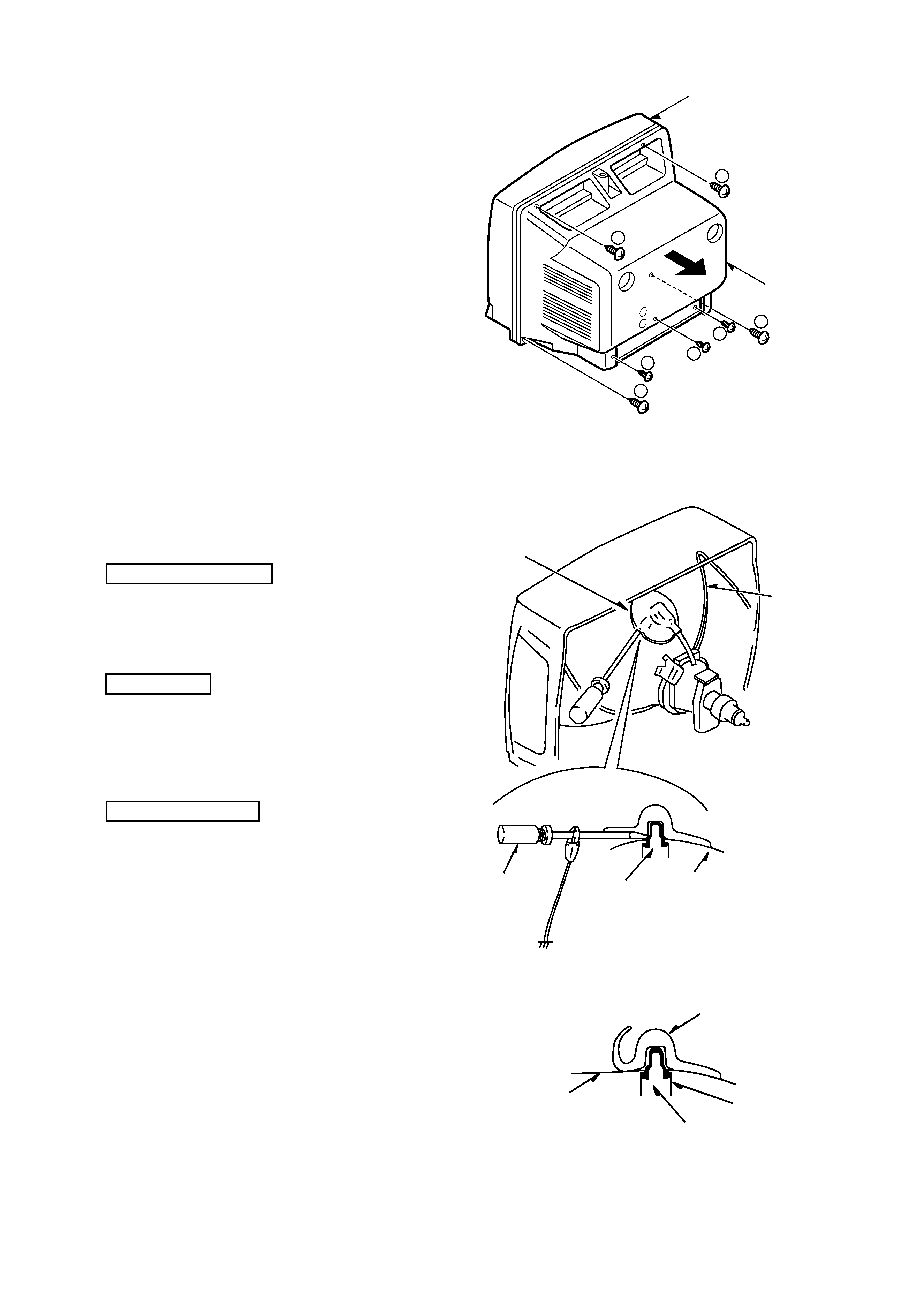
3
DISASSEMBLY INSTRUCTIONS
1.
REAR CABINET REMOVAL
(1)
Remove four screws 1 and three screws 2, then remove
the rear cabinet in the direction of the arrow. (See Fig. 1-1)
Fig. 1-1
Front cabinet
Rear cabinet
1
1
2
1
1
2
2
2.
HIGH-VOLTAGE CAP (ANODE CAP) REMOVAL
2-1.
Cautions before Removing
Discharge the anode voltage
(1)
The anode voltage is not discharged completely from the
CRT of this unit even after the power is turned off. Be sure
to discharge the residual anode voltage before removing
the anode cap.
Do not use pliers
(2)
Do not use pliers, etc. to remove the anode cap. If you used
pliers and bent the hook to remove the cap, the spring
characteristics of the hook could be lost, and when reinstalled,
the cap would come off from the CRT anode button easily,
causing an accident.
Do not turn the anode cap
(3)
If the anode cap is turned in the direction of its
circumference, the hook is likely to come off.
2-2.
Anode Cap Removal
Discharge the anode voltage. (See Fig. 2-1)
(1)
Connect a flat-bladed screwdriver to the CRT GND via an
alligator clip.
(2)
Use a tester to check the end of the screwdriver and
ground of the TV for continuity.
(3)
Touch the hook with the end of the screwdriver.
Caution : Be careful not to damage the anode cap.
(4)
Turn over the anode cap.
Caution : Be careful not to damage the anode cap.
Fig. 2-1
Fig. 2-2
CRT GND
Anode cap
Grip
Hook
CRT
CRT GND
Anode cap
Hook
CRT
Anode button
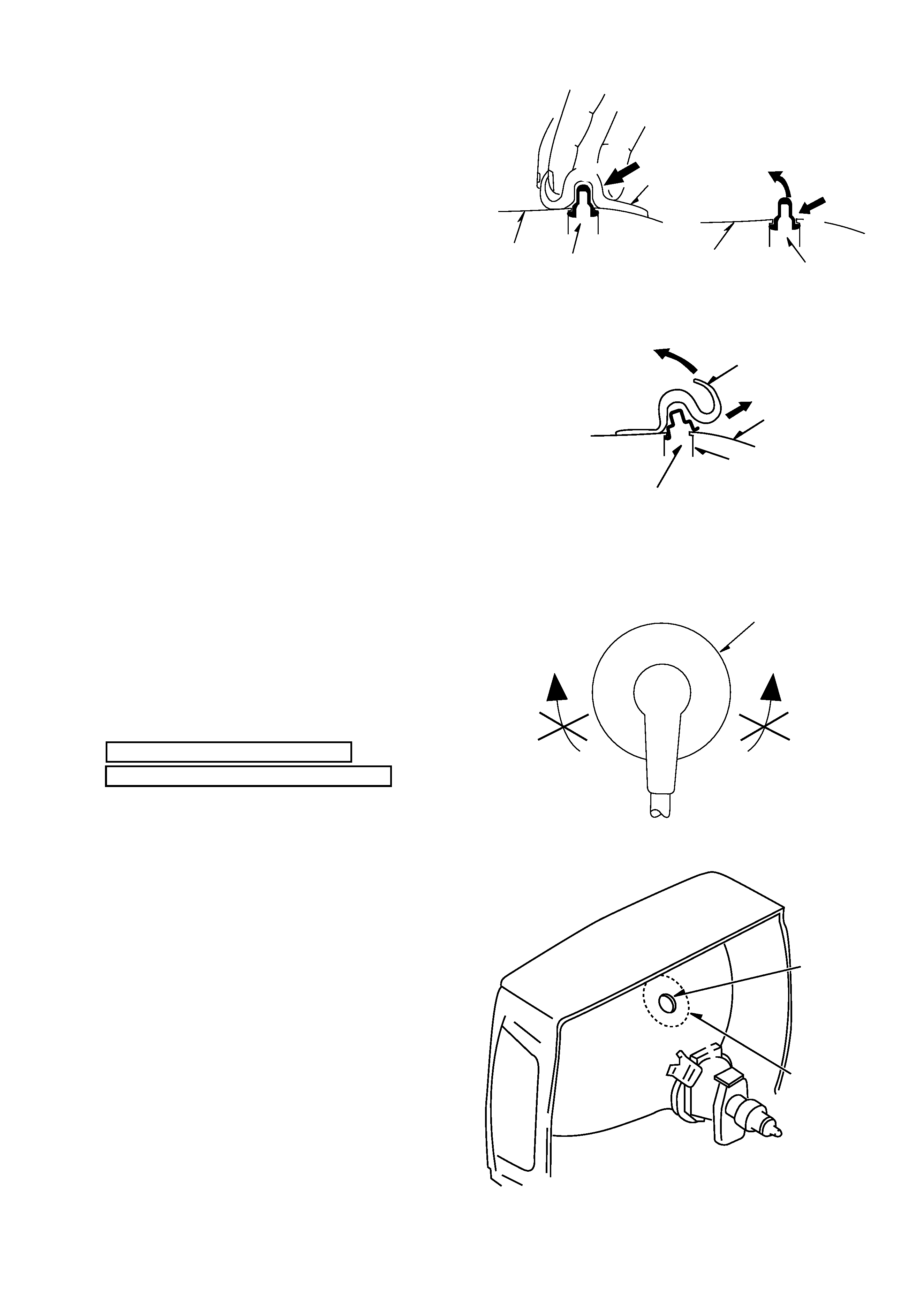
4
(5)
Push the anode cap with your thumb in the direction of
arrow 1 as shown in the figure, then lift the cap in the
direction of arrow 2 to release the hook on one side.
(See Fig. 2-3)
(6)
Turn over the anode cap on the side where the hook was
released and pull out the cap in the direction opposite to
that on which the cap was pushed. (See Fig. 2-4)
Caution : Do not pull out the anode cap straight up.
: Do not pull the cap forcibly. After removing
the cap, check that the hook is not deformed.
Fig. 2-4
Fig. 2-3
Anode cap
Pull out
CRT
Hook
Anode button
1
Hook
CRT
Anode cap
CRT
Hook
2
1
3.
ANODE CAP REINSTALLTION
Observe the cautions carefully so that no accident occurs
due to a defect in installing the anode cap and so it does
not come off.
2-1.
Caution before Reinstalling
Never turn the anode cap after installing it
Never re-use the hook when it has been deformed
(1)
If the anode cap is turned after it is installed, it may come
off. Therefore, arrange the high-voltage cable before
attaching the anode cap. (See Fig. 3-1)
(2)
If you have attached the anode cap before arranging the
high-voltage cable, arrange the cable carefully so the cap
does not turn.
3-2.
Anode cap reinstallation
(1)
Use a clean cloth moistened slightly with alcohol to clean
the installation section. (See Fig. 3-2)
Caution : Check that the installation section is free
from dust, foreign matter, etc.
(2)
Coat the anode cap installation circumference with an
appropriate amount of the specified silicone grease
(KS-650N).
Caution : Be careful that silicone grease does not
enter the anode button.
Fig. 3-1
Fig. 3-2
Left
Right
Anode cap
Installation
section
Anode button
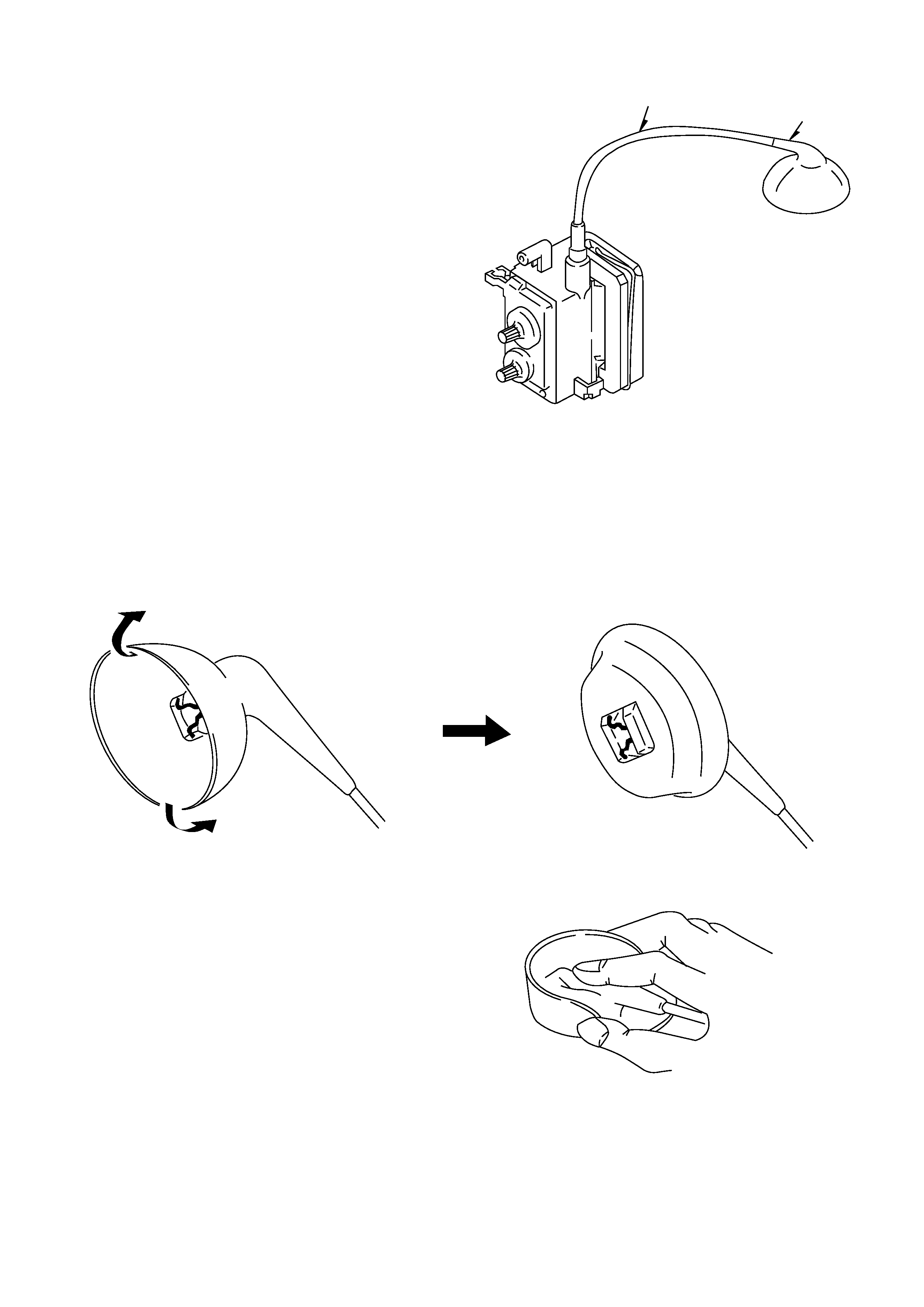
5
Fig. 3-3
High-voltage cable
Anode cap
(3)
Eliminate twisting, etc. of the high-voltage cable and
arrange it so that no twisting occurs. (See Fig. 3-3)
Caution : If the cable is not arranged correctly, the
anode cap could turn and cause an
installation defect.
(4)
Turn over the rubber cap symmetrically on the left and right.
(See Fig. 3-4)
Caution : Take great care not to damage the anode cap.
(5)
Fit your forefinger over the projection at the center of the
cap and hold the cap between your thumb and middle
finger. (See Fig. 3-5)
Fig. 3-4
Fig. 3-5
